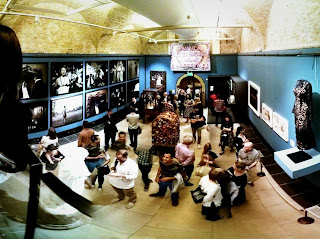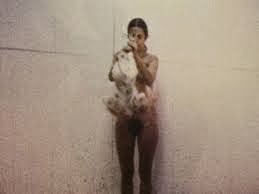Gustav Klimt: (L) Portrait of a Lady in Black, c. 1895
(R) Portrait of Hermine Gallia, 1904
Gustav Klimt and Egon Schiele feature heavily in this exhibition at The National Gallery and as you walk through the galleries it is their work which consistently jump from the walls and grab your attention. Even with contemporary eyes their work appears wonderfully alive and vibrant and so must have seemed incredibly daring and controversial at the turn of the twentieth century. The two paintings above by Klimt demonstrate not only the artist's incredible talent but also the artistic transition from salon realism to individual artist expressionism and the clash of artistic traditions which was taking place in Vienna at that time.
"Portraiture was the genre most closely associated with the flourishing of modern art in Vienna in the years around 1900. Artists focused on the image of the individual, working to the demands of patrons from the city's burgeoning middle classes. From the commemorative to the critical, the cautious to the radical, their portraits charted the changing fortunes of men, women and children facing the distinctly modern challenge of living in one of the most diverse cities of its time". [from Gallery Guide]
Schiele's edgy portraits and self-portraits rendered in his language of scratchy, diseased-looking, elongated figures are a reflection of the artist's vision and extension of his own persona, rather than actual depictions of the sitters themselves. While they confounded many critics at the time and appeared to reflect all that was deemed abject and degenerate for many, Schiele's self-portraits in particular were hugely popular and eagerly collected by his peers and other artists and intellectuals.
Egon Schiele: (L) Self Portrait with Raised Shoulder, 1912
(R) Portrait of Erich Lederer, 1912
Inevitably within all contemporary reviews of art movements the issue of female artists being excluded from art historical accounts has been re-addressed here with the inclusion of work by Broncia Koller, Teresa Ries and Elena Luksch-Makowsky, who represent a small proportion of the women who regularly exhibited at the Secession and all who had careers as public artists in Vienna. Koller was a member of the Klimt Group and a high profile figure at the centre of Viennese intellectuals, artists and musicians. Ries was once one of Vienna's most famous and successful artists and much sought after for portrait commissions. The directness of her gaze and confidence exuding from her self-portrait of 1902 in which she portrays herself in a simple work smock typifies the notion of the New Woman - a purposeful, independent, self-sufficient and modern.
Ries's depiction of her artistry and creativity is however in stark contrast to Luksch-Makowsky whose symbolist meditations permeated throughout her work and her self-portrait with her son has been read to suggest that childbirth was the ultimate creative act. This view has been subsequently challenged by many feminist critics and may in part be why her name has been forgotten.
Ultimately though, the period of erasure, murder and emigration in the Austria-Hungary empire around the two World Wars and the treatment its Jewish population ensured that these artists, along with many others who were Jewish, were lost to art history records for many years and have been among the last women artists to be rediscovered. Vienna in the 1900s reflected the ambivalent modernism of most capital cities of the time which offered unparalleled opportunities for women while at the same time continued to display misogyny towards them. Koller, Ries and Luksch-Makowsky are three artists such women who had careers as public artists, their own studios, received commissions and exhibited regularly but whose names are virtually unknown today.
Bronica Koller: Nude Portrait of Marieta, 1907
Bronica Koller: Silvia Koller with a Bird Cage, 1907-08
Teresa Ries: Self Portrait, 1902
Elena Luksch-Makowsky: Self Portrait with her Son Peter, 1901
Turn of the twentieth-century Vienna had a fascination with death. From death masks and death bed paintings, the notion of the 'beautiful corpse' was also celebratory. Two paintings by Klimt show the public and private manifestation of deathly obsessions. The hauntingly beautiful Ria Munk on her Deathbed was a commission from the deceased's family who wanted to commemorate the loss of their 24 year old daughter, who committed violent suicide (she shot herself in her heart) after the end of a love affair. Klimt's intimate drawing of his dead son, Otto who died suddenly at just one year old demonstrates the artist's fascination with death both privately and publically.
Gustav Klimt: (L) Ria Munk on her Deathbed, 1912
(R) Portrait of the Artist's Dead Son Otto Zimmermann, 1902
The new Viennese featured in this exhibition (both on and behind the canvases) reflect the intense, somewhat dark and unsurprisingly (given this was the age of Freud and analysis) introspective view of themselves. The people immortalised in these paintings reflect the experiences of the newly emerged middle classes in one of the most diverse cities of the time from their initial hopes and aspirations to their growing anxiety and alienation as world events engulfed them.
.jpg)

.jpg)
.jpg)
.jpg)
.jpg)
.jpg)

.jpg)











.jpg)





























